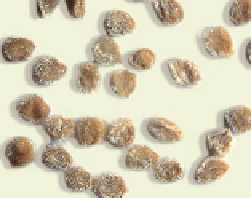Agriculture Reference
In-Depth Information
• poles or trellis and string (except for determinate varieties)
• glass jar
• coffee filter
POLLINATION NOTES
Tomatoes are predominantly self-pollinators, but cross-pollination by insects,
mainly bumblebees, can occur; there are conflicting reports as to its frequency in the literature and in
the claims of growers. Ancient forms of tomatoes were actually reliant on insects for cross-pollination,
and tomatoes did not become self-fertile until they were domesticated. Some authors are of the opinion
that the length of the style determines how great the risk of cross-pollination is. When the style is
longer than the stamen, it is easier for the stigma to be pollinated by an insect than by the flower's own
anthers. The length that the style grows to is likely determined by day length, as varieties that grow
long styles in the southern USA do not grow long styles in Europe. Gardeners growing tomato seed in
Virginia reported that bumblebees and honeybees cross-pollinated 10-15% of the varieties they were
propagating. Gardeners at Arche Noah have yet to find any significant evidence of crossing. Perhaps
the preferences of insects in the USA differ from the preferences of European bees? Tomato flowers
are not generally considered to be among the favorites of bumblebees; they only visit them when there
are no other flowers available. If cross-pollination does occur, simply do not propagate non-true-to-
type fruits further. Crossing can also be reduced by shaking trellis-bound plants at midday or several
times a day, thereby helping pollen fall from the anthers onto the stigmas.
Tomato seeds
Beefsteak tomatoes often produce double flowers on terminal panicles, which then fuse together,
forming the seams typically seen, to make one fruit. Such fruits are not a symptom of cross-pollina-
tion, nor are they malformations; the double flowers that produced them are, however, more suscept-
ible to cross-pollination.
GROWING FOR SEED
Tomatoes are grown for seed just as they are grown for food, even to pruning
suckers, which will maximize the size, number, and flavor of your tomatoes. To protect your favorite
variety from cross-pollination, take the following precautions:
• isolation distance of at least 10 ft. (3 m) for varieties whose styles are shorter than the stamens
• isolation distance of 30-40 ft. (10-12 m) for varieties whose styles are longer than the stamens
• harvest seed from fruits from the middle of the patch, developed from flowers buried deep in the fo-
liage

